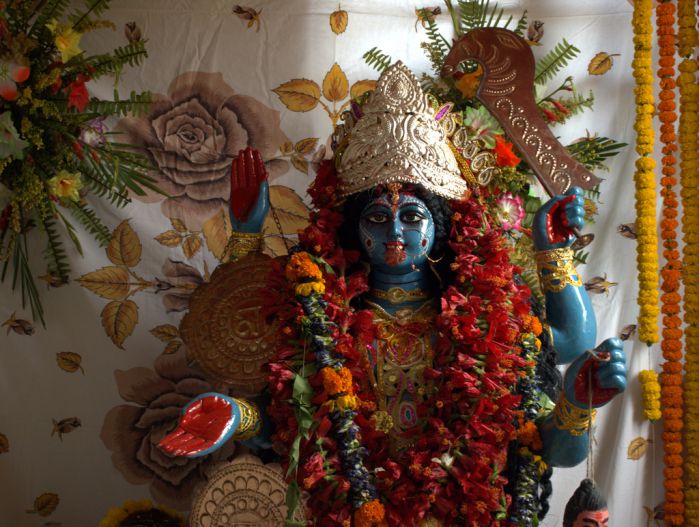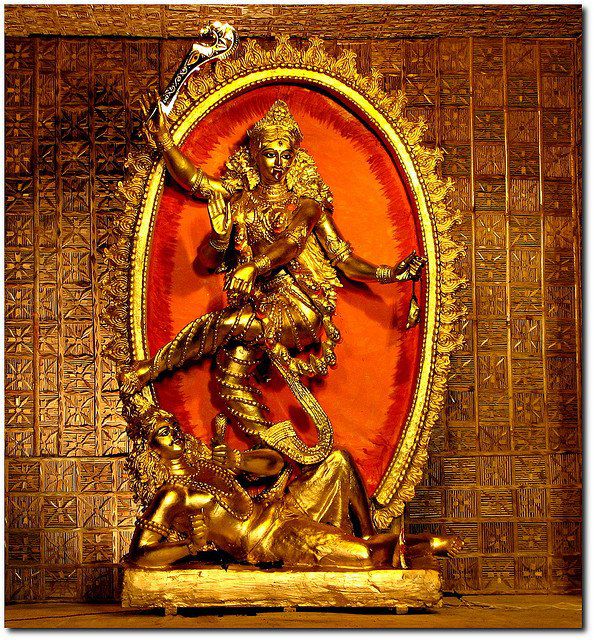No products in the cart.
Kali, the divine Protector of Earth, also known as Kalika is a Hindu goddess . But due to her destructive powers Kali is also known as “Dark Mother”. The name Kali is derived from the Sanskrit word “Kala” or time. She, therefore, represents Time, Change, Power, Creation, Preservation and Destruction. “Kali” also mean “the black one”, the feminine noun of the Sanskrit adjective Kala.
She is considered as a ferocious form of Durga/Parvati, who is the consort of Lord Shiva. Kali Ma is simultaneously portrayed as the giver, the one who bestows moksha or liberation and destructor, principally of evil forces. However, in most of the interpretations she is portrayed as ferocious and evil. She is the mother of the world and the treasure-house of compassion. She is considered as the primordial mass from which all life arouse.
Kali is the first of the 10 Mahavidyas, or manifestations of the Great Goddess, or ultimate reality. She is often portrayed standing or dancing on her consort, the Hindu God Shiva, who lies calm and prostrate beneath her. Kali is worshipped by Hindus throughout India but particularly Bengal, Assam, Kashmir, Punjab, Himachal Pradesh, Kerala, and Tamil Nadu, along with Nepal and Sri Lanka.
Kali is portrayed mostly in two forms:
The popular four-armed form : She is described as being black or blue in popular Indian art. Her eyes are described as red with intoxication and in absolute rage. Her hair is shown disheveled, small fangs sometimes protrude out of her mouth and her tongue is lolling. She is often depicted naked or just wearing a skirt made of human arms and a garland of human heads. She is also accompanied by serpents and a jackal while standing on the calm and prostrate Shiva. Kali’s most common four armed iconographic image shows each hand carrying variously a sword, a trishul (trident), a severed head, and a bowl or skull-cup (kapala) catching the blood of the severed head.
Two of these hands (usually the left) are holding a sword and a severed head. The sword signifies divine knowledge and the human head signifies human ego which must be slain by divine knowledge in order to attain moksha.
The other two hands (usually the right) are in the Abhaya (fearlessness) and Varada (blessing) mudras, which means her initiated devotees (or anyone worshipping her with a true heart) will be saved as she will guide them here and in the hereafter.
She has a garland consisting of human heads, variously enumerated at 108 or 51, which represents Varnamala or the Garland of letters of the Sanskrit alphabet, Devanagari. Hindus believe Sanskrit is a language of dynamism, and each of these letters represents a form of energy, or a form of Kali. Therefore, she is generally seen as the mother of language, and all mantras.

The ten-armed form of Mahakali : Here she is depicted as shining like a blue stone. She has ten faces, ten feet and three eyes for each head. Each of her ten hands is carrying various components which vary in different accounts, but each of these represent the power of one of the Devas or Hindu Gods and are often the identifying weapon or ritual item of a given Deva. The implication is that Mahakali is responsible for the powers that these deities possess and this is in line with the interpretation that Mahakali is identical with Brahman.
While not displaying ten heads, an “ekamukhi” or one headed image may be displayed with ten arms, signifying the same concept : the powers of the various Gods come only through Her grace. Sh has ornaments decked on all her limbs. There is, however, no association with Shiva.
She is the fast track, often on a bumpy road, to problem solution and spiritual advancement. When called by mantras that carry her vibrations, Kali responds with a direct power that often leads right through some cherished part of our ego attachments. Her power tools are the Kundalini Shakti (the power of spiritual electricity); the Kriya Shakti, the power to creatively affect the universe; and Iccha Shakti, the power of will that personally compels our physical movements and actions, while in the universe it causes the galaxies to rush away from one another into cosmic night. Although she puts “effective” before “gentle,” it should also be noted that even in the midst of the sometimes turbulent effects she produces, Kali is a repository of great compassion.
Kali Mantra

Kali Beej Mantra
In Sanskrit
ॐ क्रीं काली
In English
“Om Krim Kali”
Meaning : K stands for full knowledge,
R means she is auspicious,
I means she bestows booms, and
M means that she gives freedom.
‘SaIutation to the Supreme.’
Benefit: This mantra will protect one from all the evil forces.
Kali Mantra
In Sanskrit
ॐ क्रीं कालिकायै नमः
In English
“Om Kring Kalikaye Namah”
Meaning: This mantra is a sound representation of the Mother.
Benefit: This mantra is simple and transforms the devotee to pure consciousness.
Maha Kali Mantra
In Sanskrit
ॐ श्री महा कलिकायै नमः
In English
“Om Sri Maha Kalikayai Namah”
Meaning: ‘I bow my head to the Divine Mother, Kali.’
Benefit: One must propitiate the Divine Mother, the Primal Energy, and chant in her honour in order to obtain God’s grace.
Kalika-Yei Mantra
In Sanskrit
ॐ कलिं कालिका-य़ेइ नमः
In English
“Om Klim Kalika-Yei Namaha”
Benefit: This mantra is believed to bring relief from all kinds of problems, no matter how much complex it is.
Fifteen Syllable Kali Mantra
In Sanskrit
ॐ हरिं श्रीं कलिं अद्य कालिका परम् एष्वरी स्वा:
In English
“Om Hrim Shreem Klim Adya Kalika Param Eshwari Swaha”
Meaning: ‘O Kali, my Mother full of Bliss. In Thy delirious joy Thou dancest, clapping Thy hands together!Thou art the Mover of all that moves in thy world.’
Benefit: It is believed that this mantra brings rapid growth to one’s spirituality.
Kali Mantra for Worship
In Sanskrit
कृन्ग कृन्ग कृन्ग हिन्ग कृन्ग दक्षिणे कलिके कृन्ग कृन्ग कृन्ग हरिनग हरिनग हुन्ग हुन्ग स्वा:
In English
“Kring Kring Kring Hing Kring Dakshine Kalike Kring Kring Kring Hring Hring Hung Hung Swaha”
Meaning: The Mantra consists of three seeds, krim, hum and hrim, and the name ‘dakhshina kalike’ and ‘swaha’, which signifying offering.
Benefit: This mantra is used by the devotees of Kali, the preserver of Earth, who saves us from all the ignorance and the fear of death.
Kali Gayatri Mantra
In Sanskrit
“ॐ महा काल्यै
छ विद्महे स्मसन वासिन्यै
छ धीमहि तन्नो काली प्रचोदयात”
In English
“Om Maha Kalyai
Ca Vidmahe Smasana Vasinyai
Ca Dhimahi Tanno Kali Prachodayat”
Meaning: ‘Om Great Goddess Kali, the One and only one, who resides in the Ocean of Life and in the Cremation Grounds that dissolve the world. We focus our energies on you, may you grant us boons and blessings.’
Benefit: Through the repetition of this mantra, the aspirant’s mind becomes divinely transformed and passes from the gross state of worldly affiars into Kali’s subtle light of pure consciousness.
Dakshina Kali Dhyan Mantra
This is also known as karpuradi stotram.
“Om karala-badanam ghoram mukta-keshim chatur-bhuryam.
kalikam dakshinam dibyam munda-mala bibhushitam
sadya-chinna shira kharga bama-dordha karambujam
abhayam baradan-chaiba dakshina-dardha panikam”
Meaning: “Om Fierce of face, she is dark, with flowing hair and four-armed.Dakshina Kalika divine, adorned with a garland of heads. In Her lotus hands on the left, a severed head and a sword She bestows sanctuary and blessings with her right hands.”
Benefit : Chanting this mantra denotes the dissolving of attachments, anger, lust, and other binding emotions, feelings and ideas.
Maha Kali Mantra

“Om khargang chakra-gadeshu-chapa-parighan shulang bhushundIng shirahshankhang sanda-dhatIng karistri-nayanAng sarbanga-bhushabritam. nIlashma-dyutimasya pada-dashakang sebe maha kalikang yamastou-chhaite harou kamalajye hantung madhung kaitavam”
Meaning: ‘Aum, Her ten hands is holding a scimitar, disk, mace, arrows and bow, lance, club, a skull and a conch shell. She is a three-eyed goddess, Her body is covered with ornaments, and Her countenance with the brilliance of blue diamonds, with ten limbs. We offer our service to mahakali, She who Brahma praised for protection from the demons madhu and kaitava, when Vishnu was in sleep.’
Benefit: Kali is Mother to her devotees not because she protects them from the demons when Lord Vishnu is asleep but because she reveals to them their mortality and thus releases them to act fully and freely, releases them from the incredible, binding web of “adult” pretense, practicality, and rationality and recitation of this mantra helps in this realization.
Other Kali Mantra
a) “Om Kali, Kali! Om Kali, Kali!
Namostute, namostute, namo!
Namostute, namostute, namo!”
b) “Ananda Ma Ananda Ma Kali
Ananda Ma Ananda Ma Kali
Ananda Ma Ananda Ma Kali
Om Kali Ma!”
Benefit : These are the simple chants to salute and please the Black Goddess.
![]()
Thus, we can see that Kali’s boon is won when man confronts or accepts her and the realities she dramatically conveys to him. The image of Kali, in a variety of ways, teaches man that pain, sorrow, decay, death, and destruction cannot be conquered by denying them or explaining them away. For man to realize the fullness of his being, for man to exploit his potential as a human being, he must finally accept this dimension of existence and in return gain Kali’s boon of freedom, the freedom of the mankind to revel in the moment.
However, to gain best results one should chant and worship the Goddess properly. A few points should thus be kept in mind :
- Chanting should be started with respect, faith and honesty.
- Though one can pray any time during the day, the best time of day is 2 hours before sunrise. This is a time when one’s home and neighborhood would mostly be quiet and he can focus and concentrate without distractions.
- One should be fresh without any association with meat, alcohol, etc.
As one gets into a routine of chanting, he may begin to feel a fine vibration. The mantras start to fill one with strength and courage, which makes him more powerful than the problems he is facing and helps to solve them quickly. Reciting these, hence, brings stability to life and helps people to decide what is right and wrong in their lives.
Kali Puja :
Kali Maa is especially venerated in the festival of Kali Puja in eastern India—celebrated when the new moon day of Ashwin month coincides with the festival of Diwali. The practice of animal sacrifice is common during Kali Puja in Bengal, Orissa, and Assam, though it is rare outside of those areas. The Hindu temples where this takes place involves the ritual slaying of goats, chickens and sometimes male Water buffalos. Throughout India, the practice is becoming less common. The rituals in eastern India temples where animals are killed are generally led by Brahmin priests. A number of Tantric Puranas specify the ritual for how the animal should be killed. A Brahmin priest will recite a mantra in the ear of animal to be sacrificed, in order to free the animal from the cycle of life and death.

